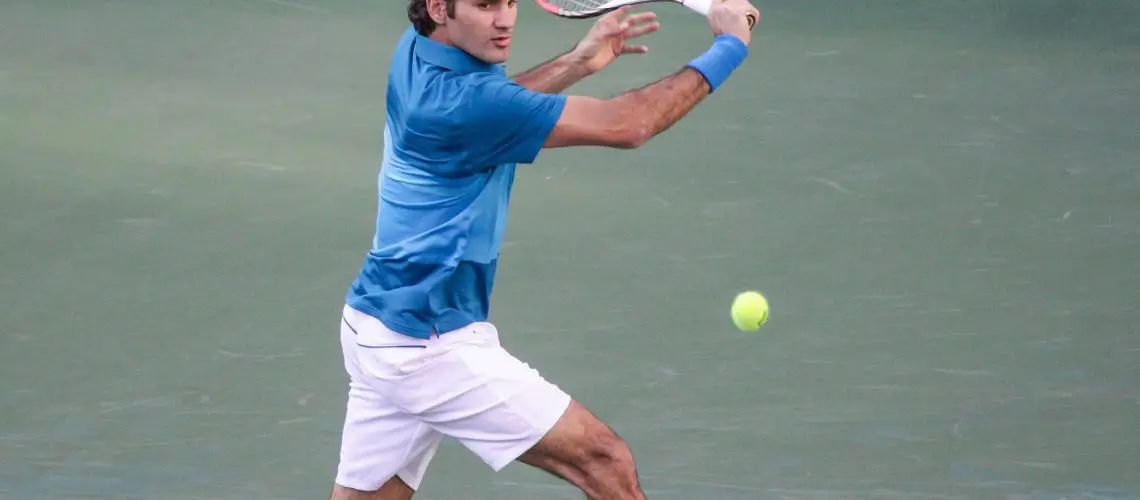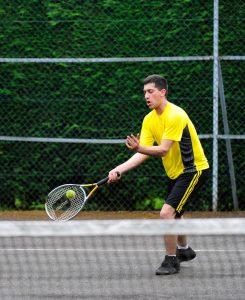We may earn money or products from the companies mentioned in this post.
Tennis Racket Strings: The Key to On-Court Success

When it comes to playing tennis, the racket strings are often overlooked but play a vital role in determining your performance on the court These seemingly small components of your racket can greatly impact factors such as power, control, and spin
1 Power
The type of strings you choose for your tennis racket can significantly affect the power behind your shots Some strings are designed to provide more elasticity, allowing for greater energy transfer from the racket to the ball upon impact This results in explosive shots that can catch your opponent off guard and give you an advantage in rallies
2 Control
Precision and accuracy are crucial in tennis, and having control over your shots is essential The right string tension and material can dictate how much control you have over the ball when hitting it Tighter string tensions offer better control as they minimize the trampoline effect of the strings, giving you a more predictable response from your racket
3 Spin
Spin is another critical aspect of modern tennis, enabling players to add variety to their shots and create difficult angles for their opponents The type of strings used can greatly impact how much spin you can generate on the ball Strings with more texture or roughness provide increased grip on the ball, allowing for enhanced topspin or slice shots
The Importance of Restringing Your Tennis Racket Regularly

While choosing the right strings initially is important, regular maintenance through restringing is equally crucial for optimal performance and injury prevention
1 Maintain Optimal Performance
Racket strings naturally lose tension over time due to continuous use and exposure to elements like humidity and temperature changes As the tension decreases, your racket’s performance also diminishes Restringing your racket at regular intervals ensures that you consistently play with optimal string tension, allowing you to maximize power, control, and spin in your shots
2 Prevent Injuries
Old and worn-out strings are more prone to breakage during play A broken string not only affects your game but can also pose a risk of injury When a string breaks, the sudden release of tension can cause the racket frame to vibrate violently, potentially leading to wrist or arm injuries By restringing your racket regularly, you reduce the likelihood of experiencing such accidents on the court
In conclusion, tennis racket strings are an often underestimated aspect of the game that can have a significant impact on your performance Understanding their role in power, control, and spin is crucial for making informed decisions about string selection Additionally, regular restringing is key to maintaining optimal performance and preventing injuries on the court
Signs Your Tennis Racket Needs Restringing

As a dedicated tennis player, you rely on your racket to deliver precise shots with power and accuracy However, over time, the strings can wear out and lose their tension, impacting your game Here are some signs that indicate it’s time to restring your tennis racket:
Loss of Tension
The tension in your racket’s strings plays a crucial role in ball control If you notice that the strings feel loose or have lost their original tension, it can lead to inconsistent ball control You may find it challenging to generate the same level of power and accuracy as before
String Wear and Fraying
Examining the physical condition of your racket’s strings is another way to determine if they need restringing Take a closer look at the strings for any visible signs of wear:
-
Discoloration:
The color of the strings may change over time due to exposure to sweat, dirt, and UV rays -
Fraying or Flattened Strings:
If you notice frayed or flattened areas on the strings, it indicates that they have worn down from repeated use -
Notches in the String Intersections:
Pay attention to the intersections where the strings cross each other Notches or grooves in these areas suggest significant wear and tear
Frequency of Play and Duration Since Last Restringing
Your playing habits also play a role in determining when you should restring your racket Consider how often you play tennis and how long it has been since your last restringing session
For regular players who hit the court multiple times a week, restringing every three to four months is recommended However, if you’re an occasional player or have a less intense playing schedule, you may need to restring your racket once or twice a year
By establishing your own restringing schedule based on your playing habits, you can ensure that your racket always performs at its best and helps elevate your game on the court
Tips for Proper Tennis Racket Maintenance and Restringing

When it comes to maintaining your tennis racket and ensuring optimal performance on the court, proper string maintenance and restringing play a crucial role Here are some essential tips to help you keep your racket in top shape:
Types of strings – pros and cons:
1 Natural gut:
Known for its excellent playability and feel, natural gut strings offer exceptional power, comfort, and control However, they tend to be more expensive than other types of strings and may not be as durable
2 Synthetic gut or multifilament:
These strings provide a good combination of power, comfort, and durability at a more affordable price point compared to natural gut They are popular among recreational players looking for a balance between performance and cost
3 Polyester or monofilament:
Polyester strings are known for their durability and control They offer great spin potential but may lack the same level of power and comfort as natural gut or synthetic gut strings
Choosing the right string tension:
1 Higher tension for more control, lower tension for more power:
String tension affects both the feel of the racket and the performance on the court Higher string tensions provide better control over shots but may sacrifice some power Lower tensions can generate more power but may lead to less precision
2 Consideration of individual playing style:
Your playing style should also influence your choice of string tension If you prefer aggressive shots with plenty of topspin, opting for a lower tension can help generate more spin and power On the other hand, if you rely on precision shots with less spin, higher string tensions can enhance your control
Professional vs DIY restringing:
1 Benefits of professional restringing services:
Professional racket stringers possess expertise in string installation techniques, ensuring that your strings are correctly installed and tensioned They have the necessary equipment to measure and maintain consistent string tension throughout the racket This can result in improved performance and longevity of the strings
a) Expertise in string installation techniques:
Professionals have honed their skills through experience, allowing them to handle various types of rackets and strings efficiently They can offer guidance on choosing the right type of strings for your playing style and preferences
b) Consistency in string tension:
Professional stringers utilize specialized machines to achieve precise and consistent tension across all strings This consistency leads to a more predictable response from your racket, enhancing your overall performance on the court
2 Weighing cost-effectiveness:
While professional restringing services come with a cost, it is essential to consider the long-term benefits they provide Properly maintained strings last longer, reducing the frequency of restringing required Additionally, professional stringers can help you maximize your investment by recommending durable strings that suit your playing style
Maintaining and restringing your tennis racket regularly is crucial for optimal performance during matches By understanding the different types of strings available, choosing suitable string tensions based on your playing style, and considering professional restringing options, you can ensure that your racket remains reliable and performs at its best when you step onto the court
Conclusion: Ensuring Optimal Performance with Regular Restringing

Recapitulating key points to recognize when a racket needs restringing
In this article, we have explored the importance of regular restringing for maintaining optimal performance in your racket We discussed the signs that indicate when it’s time to restring, such as loss of tension, frayed or broken strings, and decreased control and power By being aware of these indicators, you can proactively address any string-related issues before they negatively impact your game
Remember, even if your strings appear to be intact and undamaged, they can still lose tension over time due to natural wear and tear This gradual loss of tension can significantly affect your ability to control the ball and generate power in your shots Therefore, it is crucial to keep an eye on the performance of your racket and not rely solely on visual cues when determining whether restringing is necessary
Additionally, we discussed the role of string material and gauge in influencing both performance and durability Understanding these factors will help you make informed decisions when selecting new strings for your racket Whether you prefer polyester for its durability or multifilament for its enhanced feel and comfort, choosing the right strings tailored to your playing style can greatly enhance your overall experience on the court
Encouraging players to develop good maintenance habits
Beyond recognizing when a racket needs restringing, it is equally important to establish good maintenance habits that prolong its lifespan Regularly cleaning your racket after each use helps remove dirt, sweat, and debris that can accumulate between the strings and frame over time This simple routine not only improves hygiene but also prevents premature wear and tear
In addition to cleaning, storing your racket properly is crucial for maintaining its performance and integrity Avoid leaving it in extreme temperatures or direct sunlight, as this can cause the strings to weaken and the frame to warp Investing in a quality racket cover or case provides an extra layer of protection during transportation, preventing accidental damage that could require immediate restringing
Lastly, remember that restringing your racket is not a one-and-done solution Regular maintenance and care are essential for ensuring consistent performance and prolonging the lifespan of your racket By incorporating these habits into your routine, you’ll be able to maximize your playing potential and enjoy your game to the fullest
Useful Links

How often should you restring your tennis racket?
Why You Should Restring Your Tennis Racquet
How do I know when it’s time to restring my raquet? : r/10s
When is it time for a new tennis racquet
FAQs About Stringing Your Tennis Racquet
When do I need to restring my tennis racket?
How often should you Change Tennis Strings?
Replacing vs. Restringing a Tennis Racket
When Should You Restring Your Tennis Racket?
All About Tennis Strings
How Often Should I Restring My Racket?
Tennis Stringing & Racquet Services at DICK’S …
Our Guide To Squash Racket Restringing
How Long Do Tennis Racket Strings Last? Let’s Check!
Tennis Racquet Stringing – False Economy by Tennis Players
How to Restring Your Own Tennis Racquet : 8 Steps
Racket Restring Cost: A Comprehensive Comparison | String JB
The Best Tennis String Tension Guide
How do I know if my tennis racket needs restringing?






